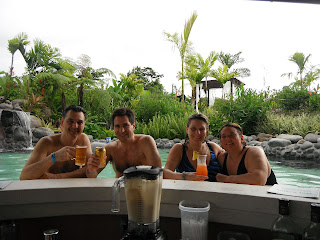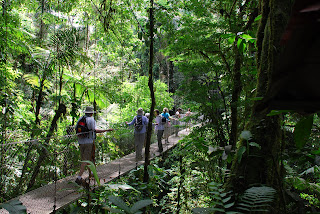 |
| Having a bite just outside San José airport |
I don't know what fascinates me about volcanoes but I seem drawn to them...in Hawaii, in Iceland, in Costa Rica. They are powerful forces of nature that are tame and calm most of the time, but every once in a while show their brute force.
Much to my pleasure (and Nancy's too) our first hotel was at the foot of Arenal, an active but calm volcano, apparently the most visited tourist site in Costa Rica. As soon as we arrived we were mesmerized by that volcano.
 |
| The view from our "cabin" |
We stayed in a semi-detached cottage, Nancy and Serge on the left and we were on the right as per the photo. Our rooms opened up in the back with a view of the volcano which was surprisingly clearly visible. I had read that the best time to see the majestic volcano was October; but as you can see by the photos we could clearly see it at the end of April.
Our cabins formed a little "resort village" with little streets and well-manicured gardens. We would sit out on our chairs and gaze out at the clouds skittering across the cone of the volcano, sometimes wrapping themselves around the peak. When one thinks of a volcano, one thinks of this very sight - an inverted cone with a crater at its peak which spews out the lava. The volcanoes in Hawaii were much bigger and had numerous caldera and vents; and the ones in Iceland also much bigger than this one and covered by glaciers; much, much different.
 |
| Banana tree - see the bird on the bananas? |
 |
| On the road in our little resort "neighborhood" going to take a dip in the hot springs |
 |
Here's a Heliconia on our property.
We loved the concept of this hotel. The privacy of our own little cottage surrounded by nature, the full amenities of a hotel, breakfast included, fantastic views. It's a taxi ride into town but well-worth the stay! Ask for a set price for the taxis before you get in.
http://www.arenalspringshotel.com/index.php
With volcanic activity come hot springs. Our resort had a pool, but we used the hot springs mostly. The higher up the pool, the warmer the water, which cascaded down into a main pool where there was a swim-up bar.
Our first excursion was a Hanging Bridges Natural History Walking Tour. http://www.hangingbridges.com/ If you do nothing else in Costa Rica, you must do a hanging bridges tour which could be found in all 3 of the places we visited in Costa Rica.
Get a guide because they see animals you never will! It's a walk around the tropical rain forest from 3 different perspectives. First the ground level which is always damp and surprisingly cool because it is covered by the trees (or canopy) which drive rainwater down their trunks to the floor.
You often see little streams at the bottom often with small cascades. At this level you see ants and insects of all kinds, frogs, snakes, lizards and of course birds are seen at all levels. Sometimes you really have to look carefully as the animals are kings at camouflage!
Jesus Christ Lizard on the left (because it runs on water!). A snake on the right... anyone know its name?
 |
| Iguana - big guy (up to 2 m long and weighing 10 kg) |
The second part of the tour is at mid-tree level, you see many species of birds and other animals that live in the trees.
Leaf cutter ants spend their entire lives marching from their nests underground towards the trees, climing as high as they can to get the greenest, freshest leaves, climbing back down that tree with their leaves on their backs (as per the photo below) and following a path back to their nests. Often it looks like a stream of leaves flowing on the rainforest floor.
 |
| Leaf Cutter Ants |
Lastly you climb up above the canopy into the sun! The view is for miles and you see the forest from a bird's-eye view.


Our hanging bridges tour was during the daytime. In Monteverde we did a night walk. You see many different animals active during the day than at night.
Later on each day we visited La Fortuna village. The town emerged after the destructive eruption of the formerly "dormant" volcano in 1968 which destroyed the towns of Tabacon, Pueblo Nuevo and San Luis located more to the west of the volcano. This area was agricultural and the farmers felt that their area had the good "fortune" of being spared as it was on the east side, hence the town grew as La Fortuna and has thrived as a tourist town ever since.
 |
| A little coffee shop beside the town square |




Nearby to the town is a quaint little waterfall. So we took a taxi and hiked down to see it and took a dip. The water was refreshing after a brisk hike.


























I think the snake is likely a morph or subspecies of Eyelash Pit Viper.
ReplyDelete